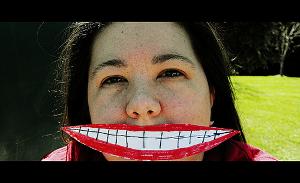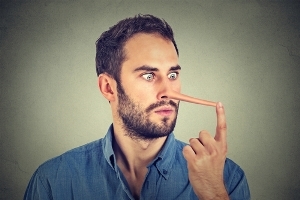How to Read People
6 ways to know what they're really thinking
 "But what does that smile mean?" courtesy of meddygarnet
"But what does that smile mean?" courtesy of meddygarnet"Deafness has left me acutely aware of both the duplicity that language is capable of and the many expressions the body cannot hide." ~ Terry Galloway, American performance artist.
People are perverse or - let's be fair - they can be. You think you read them right and wham! They do something to confound your expectations.
She'd sat watching me for two days, intermittently sighing like a ripped inflatable boat; channelling a disappointed school teacher woefully bearing the inept mutterings of the class dimwit.
She looked bewildered, then baffled by my presentations on the nature of depression and its relation to the trance state, shaking her head in a way that screamed: "You're an idiot!"
"Had we been married in a previous life?" I silently wondered.
Still, everyone else seemed to enjoy the workshop, so I tried not to focus on this John Wilkes Booth to my Abe Lincoln as I presented. But concentrating can be hard when one woman present looks as if she'd happily pull an AK47 assault rifle on you and use it without whim.
Worse was to come because - horror upon horror! - as I was preparing to leave at the end, this woman approached me. The downturned corners of her mouth threatened to drag along the carpet. I pretended to be preoccupied with different coloured flip chart markers.
"Excuse me, I just want to say..."
"Yes?"
"...how much I loved the workshop. It's been fun and I've truly leaned a great deal." Her face contorted into a smile and with that she was gone. I scooped up my lower jaw and wondered: "What just happened? How could I have read this woman so wrong?"
I learned three things from this experience:
- Not to worry too much about what people think or don't think.
- Not to assume everyone nonverbally communicates in identical ways to everyone else (though, as we'll see, there is much overlap).
- Not to let emotion cloud my perception when it comes to reading others.
Some people such as the late great Dr Milton Erickson (1) and Dr Joseph Bell, the true-life inspiration behind mythical detective Sherlock Holmes (2), had legendary powers of perception and observation that left people wondering whether they had telepathic powers. How did they do it?
Body language and fleeting expressions
We've all seen body language books and some of what they offer may be worthwhile, but, like those 'dream dictionaries' that assume people never produce their very own unique symbolism, they are just too general. You know the kind of thing: If someone stands in a certain way with their feet pointing at you, it means they're willing to have your babies and run off to Honolulu with you! It is useful to study body language and facial expression, but with a caveat.
Sometimes what people seem to show and what may really be going on are two different things depending on your state of mind at the time.
I was assuming that woman's pained look of trying to assimilate some new, challenging ideas meant she was struggling with me as a person. Unless we're calm and really look clearly, we can assume we see what is not there and also miss some vital clues as to what is.
Body language can tell us an awful lot, as can facial expressions, but we have to allow for individual differences in expression. So what do people's facial expressions tell you about them?
Angry faces look the same
It's true that there are some cultural differences in the way we express ourselves around the world. In some cultures, you can get into trouble just by the way you wave your hand (3).
Some anthropologists believed people learned what to do with their faces when angry (scowl, intense look, flared nostrils, arched eyebrows) from other people. Or that the only reason we don't smile sweetly when sad is because we've learned the sad look from other people in our culture. It was thought facial expressions and body language were acquired rather that hardwired.
The great psychologist Paul Ekman showed that facial expression of emotion is not culturally determined, but universal across human cultures. Whether you happen to be a Manhattan banker or a New Guinea tribeswoman, your expression of emotions such as anger, disgust, fear, joy, sadness, amusement, embarrassment, surprise, and shock will be recognizable worldwide. And these are pretty easy to read in the faces of other people.
The charade of adult life
People, especially once they join the adult world, like to 'put on a face'. Some people smile when they don't want to because they assume the occasion calls for it. You'll have seen this if you've ever been served by cabin crew at 30,000 feet. We might even fake looking sad on occasion if we know others are sad and that we're 'supposed' to feel that way too. Perhaps your neighbour is inconsolable because her annoying super-yappy sausage dog has been run over and you don't want to be grinning from ear to ear like you've won a sweepstake, so you act a bit sad. Much of adult life is (or can be) an act, often for altruistic reasons. So what can you do to read people better?
1) Look out for 'microexpressions'
Sometimes the mask slips. For the merest snatch of time, you'll see a true expression; what they're really thinking flashes out at you. Maybe the consoling neighbour lets out a gleeful smirk for less than 1/15th of a second (which is about how long these microexpressions last) or the cabin crewmember smiles with their mouth but seems to scowl with their eyebrows when you ask for more coffee.
The truth has a way of slipping out, but you need to look out for these fleeting 'microexpressions'. It's easy to fake body language and paste an expression onto your face; and it's also easy to be taken in (4). But if something doesn't 'feel right', look for microexpressions which are almost, but not quite, subliminal. Shooting stars don't last long, but you know when you've seen one.
2) Look for partial expressions or fleeting full ones
Psychologist Paul Ekman describes how microexpressions or 'tells' - which are, as he described, "very fast and intense expressions of concealed emotion" - can take two forms.
- A full but so fast as to be (almost?) missed expression, such as the waiter who serves you up a 1/15th of a second look of utter contempt when you ask for ketchup with the chef's finest creation. This is a complete expression, but so fast you might miss it as it melts back into the professional smile.
- Partial microexpressions contained in only part of the face. These partial 'tells' may last longer than full expressions, but only show on parts of the face such as around the eyes or the mouth. A classic one might be eyes and eyebrows looking angry whilst mouth smiles.
3) Don't assume
It's important not to assume you know what you're looking for, because we can so often think we've found what we haven't. If you assume someone 'must' be angry, for example, then everything they say and do will seem like concealed anger to you. The woman at the workshop went on to do other training with us and I noticed (when I was calm) that she always looked a little pained when she was concentrating, as many of us do. I had quickly assumed that because she wasn't grinning like a teenager on a funfair ride, she wasn't enjoying herself.
Remember that we tend to see others through the lens of our prevailing emotion, so work to relax when watching people. Keep your mind nice and open.
4) Look for patterns
That cabin crewmember may have had an argument with her boyfriend before her shift and still be feeling angry about that as she serves you above the clouds. You don't know. But if you notice that she seems to display a microexpression of contempt at a particular passenger every time he drunkenly yells for more Smirnoff, then that's a pattern you've spotted.
Like the 'don't assume' tip, looking for patterns helps you keep more objective when observing others.
5) Watch what people do
People will tell you all kinds of things about what they think and feel and perhaps most of the time you can trust that. But people kid you - and themselves.
Look for 'incongruence', which means a seeming disconnect between a person's words and their expressions and body language. For example, someone is telling you they really love someone, but every time they mention that person, they shake their head. Or if they tell you something makes them happy but frown as they say it (believe you me, I've seen this many times), then that might be telling you something significant. The trick is not to assume you know for sure what that's telling you until you have more information.
Maybe they do love this person but feel this person doesn't love them back - hence the headshake; maybe this something does make them happy but they fear losing it - hence the frown. We don't know until we know. Practice watching chat shows (or talk shows) on TV with the sound down and guess what the people are feeling when they are talking, then watch again with the sound up and see if their words match their apparent facial expressions.
6) Merge with people's minds to feel what they feel
Genuine body language and facial expression reflect how we feel, but amazingly how we feel can be changed by adopting certain postures and facial expressions. Around 30 seconds of fake smiling can make you feel better (5), and sitting in an open, confident way can raise testosterone levels (as tested in men) and make you feel more confident, even if you didn't feel that way to begin with (6). So 'faking it 'til you make it' can and does affect hormonal levels and your emotional state in a kind of two-way feedback loop.
It's also been noted that when two people 'see eye to eye', they will naturally and quite unconsciously mirror one another's facial expressions, rate and types of movement, and body posture. But how about this? If you are with someone, try adopting their body posture, facial expressions, and so forth; not just to build better rapport, but to see how adopting these expressions makes you feel, as a way of discovering how they might be feeling.
Next time someone tells you they are not worried or they are happy, try seeing for yourself whether their body and facial movements seem to reflect these feelings by adopting them yourself. Of course, this needs to be done subtly or they'll notice.
I believe we can, with practice, become much better at reading people, perhaps to an astonishing degree. But ultimately, we can and should take people at face value and not be trying to 'read' them all the time, unless we feel something doesn't add up. It's worth remembering the words of the great fictional detective Sherlock Holmes, that most famous of people-readers:
"The temptation to form premature theories upon insufficient data is the bane of our profession."
Look, see patterns, and bit by bit form conclusions - but only when all the 'evidence' is in.
References
- Erickson contracted polio as a very young man, and was immobilized for many months and physically debilitated for the rest of his life. He is quoted as saying that his physical limitations had made him more observant, and certainly his powers of observation were legendary. On more than one occasion, he seemed to read people's minds.
- Dr Joseph Bell was, in part, the inspiration for Arthur Conan Doyle's creation Sherlock Holmes. He was known as 'The Father of Modern Forensics' and could, it seems, randomly pick a stranger and, by careful observation, be able to tell his occupation and recent activities - something that his fictional counterpart would also sometimes do.
- For example, in Iran the 'thumbs up' gesture seen as such a positive gesture in the west is considered a great insult.
- Psychologist and world-renowned facial expression expert Paul Ekman found after testing 20,000 people from all different backgrounds that only 50 people had the capacity to reliably spot lies without any training in doing so. (See 'How to Tell if Someone is Lying'.)
- Liverpool University's Professor of Clinical Psychology and Headroom consultant, Peter Kinderman, states: "There is considerable scientific evidence that just the physical act of a smile can induce positive emotions in a smiler, just as standing straight and looking up can help us feel more confident."
- Research conducted by Dr Amy C.J. Cuddy, a social psychologist at the Harvard Business School, found that adopting an open body posture increased testosterone levels and lowered stress hormone. Looking confident can make us feel more powerful!






